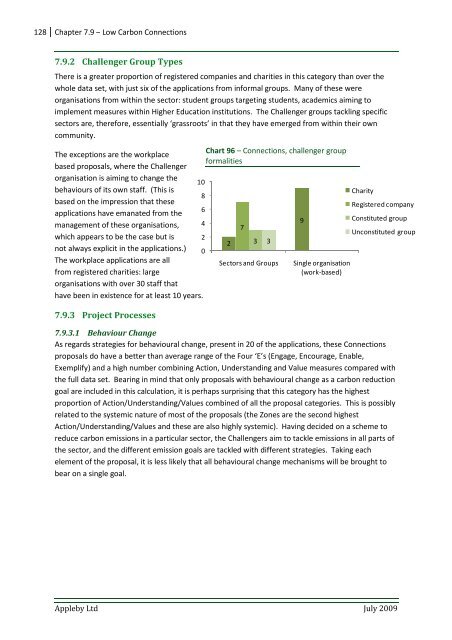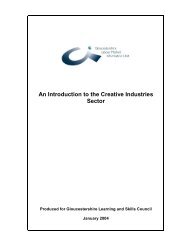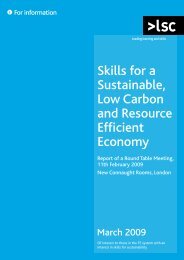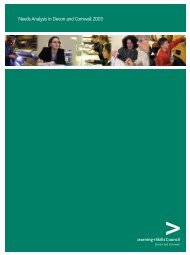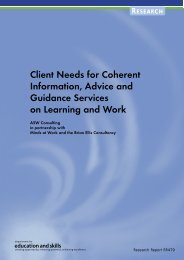Mapping the Big Green Challenge - The Skills & Learning ...
Mapping the Big Green Challenge - The Skills & Learning ...
Mapping the Big Green Challenge - The Skills & Learning ...
You also want an ePaper? Increase the reach of your titles
YUMPU automatically turns print PDFs into web optimized ePapers that Google loves.
128 Chapter 7.9 – Low Carbon Connections7.9.2 <strong>Challenge</strong>r Group Types<strong>The</strong>re is a greater proportion of registered companies and charities in this category than over <strong>the</strong>whole data set, with just six of <strong>the</strong> applications from informal groups. Many of <strong>the</strong>se wereorganisations from within <strong>the</strong> sector: student groups targeting students, academics aiming toimplement measures within Higher Education institutions. <strong>The</strong> <strong>Challenge</strong>r groups tackling specificsectors are, <strong>the</strong>refore, essentially ‘grassroots’ in that <strong>the</strong>y have emerged from within <strong>the</strong>ir owncommunity.<strong>The</strong> exceptions are <strong>the</strong> workplacebased proposals, where <strong>the</strong> <strong>Challenge</strong>rorganisation is aiming to change <strong>the</strong>10behaviours of its own staff. (This is8based on <strong>the</strong> impression that <strong>the</strong>se6applications have emanated from <strong>the</strong>management of <strong>the</strong>se organisations, 4which appears to be <strong>the</strong> case but is 2not always explicit in <strong>the</strong> applications.) 0<strong>The</strong> workplace applications are allfrom registered charities: largeorganisations with over 30 staff thathave been in existence for at least 10 years.7.9.3 Project ProcessesChart 96 – Connections, challenger groupformalities273 3Sectors and Groups9Single organisation(work-based)CharityRegistered companyConstituted groupUnconstituted group7.9.3.1 Behaviour ChangeAs regards strategies for behavioural change, present in 20 of <strong>the</strong> applications, <strong>the</strong>se Connectionsproposals do have a better than average range of <strong>the</strong> Four ‘E’s (Engage, Encourage, Enable,Exemplify) and a high number combining Action, Understanding and Value measures compared with<strong>the</strong> full data set. Bearing in mind that only proposals with behavioural change as a carbon reductiongoal are included in this calculation, it is perhaps surprising that this category has <strong>the</strong> highestproportion of Action/Understanding/Values combined of all <strong>the</strong> proposal categories. This is possiblyrelated to <strong>the</strong> systemic nature of most of <strong>the</strong> proposals (<strong>the</strong> Zones are <strong>the</strong> second highestAction/Understanding/Values and <strong>the</strong>se are also highly systemic). Having decided on a scheme toreduce carbon emissions in a particular sector, <strong>the</strong> <strong>Challenge</strong>rs aim to tackle emissions in all parts of<strong>the</strong> sector, and <strong>the</strong> different emission goals are tackled with different strategies. Taking eachelement of <strong>the</strong> proposal, it is less likely that all behavioural change mechanisms will be brought tobear on a single goal.Appleby Ltd July 2009


